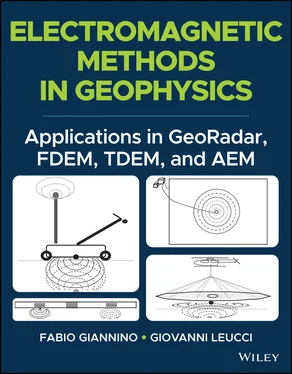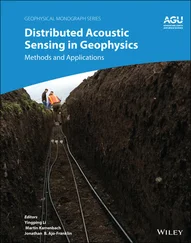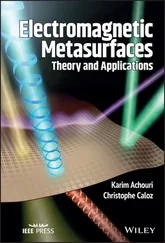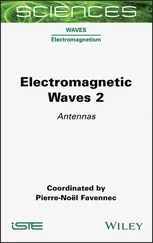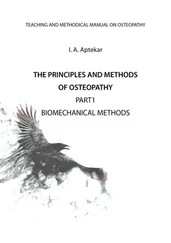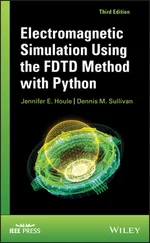1 ...8 9 10 12 13 14 ...19 10 Leucci, G. (2015). Geofisica Applicata all’Archeologia e ai Beni Monumentali. Dario Flaccovio Editore, Palermo, pp. 368.
11 Persico, R., Piro, S., and Linford, N. (2018). Innovation in Near‐Surface Geophysics Instrumentation, Application, and Data Processing Methods. Elsevier. pp. 534.
12 Persico, R. (2014). Introduction to Ground Penetrating Radar: Inverse Scattering and Data Processing. Wiley.
13 Reynolds, J.M. (2011). An Introduction to Applied and Environmental Geophysics. Wiley, Chichester.
14 Turner, G. and Siggins, A.F. (1994). Constant Q attenuation of subsurface radar pulses: Geophysics, 59, 1192–1200
15 Ward, S.H. and Hohmann, G.W. (1987). Electromagnetic Theory for Geophysical Exploration, in Electromagnetic Methods in Applied Geophysics, vol. 1, chap. 4, ed. M.N. Nabighian, Soc. Expl. Geophys.
16 Ylmaz, O. (1987). Seismic Data Processing, Society of Exploration Geophysicists.
2.2. FREQUENCY DOMAIN ELECTROMAGNETIC (FDEM) METHOD: OPERATIVE PRINCIPLE AND THEORY
2.2.1. EM Waves and Fundamental Quantities
The so‐called “ low induction number ” FDEM methods are based over a rather complex theoretical background that is the theory of the EM waves propagation. It is beyond the scope of this book to illustrate in detail the physical and mathematical aspects of the EM theory hence, a reasonably simplified vision of the features of the EM theory shall be given. Other textbooks, such as Nabighian, 1988 just to cite one example, may be taken as a reference for an in‐depth into the EM theory. However, the reader shall gain all the information and details necessary to support comprehension of the FDEM methodology and its application for the practical aspects for shallow modeling of the subsoil for many types of applications.
The introduction to this theory, is illustrated through two typical examples, schematizing simple laboratory tests ( Figure 2.2.1).
Being a coil made of metal (copper, for example) connected to an ammeter as illustrated in the sketch of Figure 2.2.1, above.
Let the magnet be standing still in a position close to the coil ( Figure 2.2.1– 2). No electric current is measured at the ammeter, under this condition.

Figure 2.2.1 1) The magnet does not move and no electric current is measured; 2) when the magnet is moved towards the coil, a positive sign electric current is measured; 3) when the magnet is pushed outside the coil, a negative sign electric current is measured
(modified from F. Giannino, 2014).
When the magnet is moved towards the coil ( Figure 2.2.1– 2), the copper coil itself “senses” the magnetic fields due to the presence of the moving magnet, and a positive electric current is measured at the ammeter.
Then, when the magnet is moved towards the opposite direction (i.e. outside the coil, Figure 2.1.1– 3), an electric current showing negative sign shall be measured by the ammeter.
If the operation above illustrated (parts 2 and 4 of Figure 2.2.1) is reiterated multiple times, an electric current alternating between positive and negative values, is generated at the coil and measured by the ammeter.
From the above it can be deduced that a time varying magnetic field located in the vicinity of a metallic conductor, generates an alternating electric current (of a given frequency f (in Hz ) and amplitude A (in Amp )) to flow in the conductor itself.
The above concept represents the basic idea on which the design of geophones , used for seismic prospections, is based. Geophones (a sort of portable seismographs, so to say) are essentially made of a coil inside which a magnet is located: the coil is united to the external framework of the geophone, whereas the magnet can move freely inside the coil, without never touching this latter. As an elastic (seismic) wave interacts with the geophone coupled to the surface of the terrain, the magnet inside the coil move according to the external force due to the passing seismic wave. The soil motion is then “translated” into a sinusoidal signal whose frequency and amplitude are proportional to the magnet motion inside the coil, hence to the seismic wave.
Then signal digitizing techniques, allows for this elastic wave(s) to be visualized as seismograms, characterized, among other aspects, by the frequency and amplitude.
The effect of the simple experiment illustrated in Figure 2.2.1(the first one above) is described by Faraday’s law.
According to Faraday’s law, when a time‐varying magnetic field is applied in the vicinity of a coil (conductor), an electric field is generated within the conductor itself.
Faraday’s law can be expressed by the mathematical formulation:
(2.2.1) 
In (2.2.1), E represents the amplitude of the electric field (V/m) and B is the magnetic induction vector (Weber/m 2or tesla ).
One more experiment is illustrated in the sketch in Figure 2.2.2, where an electric current I passes through a metallic wire made of n loop (a coil).
In this case, it is experimentally demonstrated that a metallic coil where an electric current I is applied, generates a magnetic field and the amplitude of this magnetic field is proportional to the amplitude of the electric current applied.
The experiment just illustrated can easily be conducted by connecting a metallic coil to a small battery; then, a small metallic needle is to be placed inside the coil. The needle should not be in contact with the coil. Also, fine dust of iron should be placed nearby the two ends of the needle.
When the battery is switched on, it can be observed that, the fine iron dust placed near the needle’s ends, is attracted by the extremities (poles) of the needle itself as an the electric current is passing through the coil, generating a magnetic field.

Figure 2.2.2 A magnetic field is generated (dashed splines) when an electric current I is passing through a coil of metallic wire (solid black line) (modified from F. Giannino, 2014).
The effect of this experiment is mathematically described by the Ampere’s law, which states that to every time‐varying electric field, a magnetic field is associated. Ampere’s law is expressed by the following:
(2.2.2) 
Where, H is the magnetic field intensity (in A/m), I is the electric current density (A/m 2), and D is the electric displacement (C/m 2).
Further to the above, the electric field (as well as the magnetic field) relates with their own source, through the Gauss Law, through the following equations:
(2.2.3) 
(2.2.4) 
Equations (2.2.1), (2.2.2), (2.2.3), and (2.2.4)are known as Maxwell’s equations. This set of equations are designed to draw a relation between the above described vectors and their source, and also with the electric charge density q (C/m 3), and with the density of electric current I (A/m 2) (P.V. Sharma, 1997).
Читать дальше
